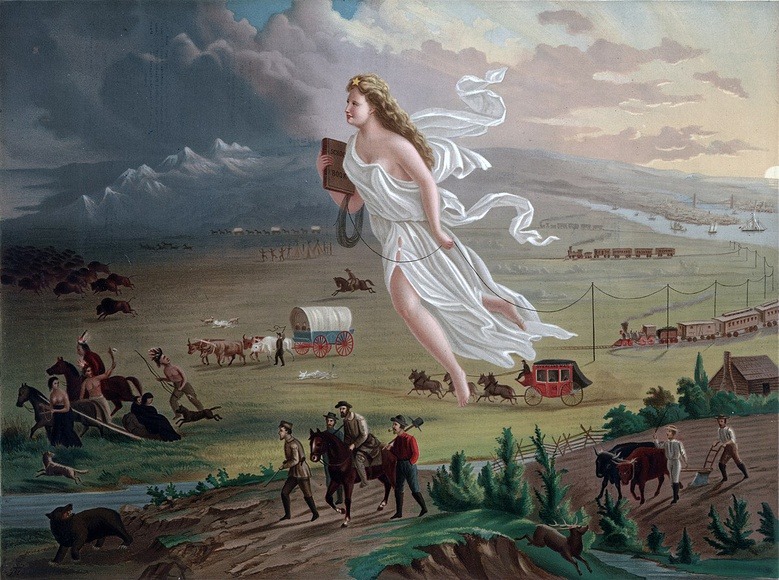Manifest Destiny 1800-1860

Overview
"Although called into name in 1845, manifest destiny was a widely held but vaguely defined belief that dated back to the founding of the nation. First, many Americans believed that the strength of American values and institutions justified moral claims to hemispheric leadership. Second, the lands on the North American continent west of the Mississippi River (and later into the Caribbean) were destined for American-led political and agricultural improvement. Third, God and the Constitution ordained an irrepressible destiny to accomplish redemption and democratization throughout the world. All three of these claims pushed many Americans, whether they uttered the words manifest destiny or not, to actively seek the expansion of democracy. These beliefs and the resulting actions were often disastrous to anyone in the way of American expansion. The new religion of American democracy spread on the feet and in the wagons of those who moved west, imbued with the hope that their success would be the nation’s success." - American Yawp, Chap 12 Introduction
[Image - John Gast, American Progress, 1872. Wikimedia.]
Learning Objectives
- Describe in what ways did the Missouri Compromise impact the United States?
- Explain the underlying causes of the expansion of the United States.
- Analyze the impact of the gold rush on California
- Describe the consequences of the Mexican War, and especially how the Mexican territorial acquisitions explosively opened the slavery question.
- Identify the short-term and long-term consequences of the Mexican War on the United States?
- Explain why the United States eventually incorporated “all of Texas,” but not “all of Oregon” or “all of Mexico”?
- Describe components of the Compromise of 1850
- Identify the expansion processes that completed the continental United States.
Textbook Readings
Boundless US History
"The Westward Movement and Manifest Destiny: 1812–1860"
Expansion and the Mexican-American War
Conclusion: The Effects of Westward Expansion
Alternative Textbook Resources
US History - OpenStax
Chapter 11: “A Nation of the Move“
The American Yawp
Chapter 12: “Manifest Destiny”
History in the Making a History of the People of the United States
Chapter 14: “Westward Expansion”
Module Supplemental Readings/Videos
- Manifest Destiny
- Missouri Compromise
- The Texas Revolution
- The Texas Question in American Politics
- The Mexican War
- US-Mexican War (PBS)
- An Uneasy Peace
- The Gold Discovery
- The Gold Rush
- The Compromise of 1850
Multimedia
- Westward Expansion & Manifest Destiny
- Manifest Destiny
- The Missouri Compromise
- War & Expansion: Crash Course US History
- The Gold Rush
- America the Story of Us: Gold Rush
- The Compromise of 1850
- The Fugitive Slave Act of 1850
Primary Source Documents
- John Tyler & the Missouri Crisis
- Missouri Compromise: Primary Documents
- A Tejano Favors Anglo Immigration
- Declaration of the People of Texas
- John Quincy Adams Denounces Texas Annexation
- the Settlement of the Oregon Boundary
- Treaty of Guadalupe Hidalgo
- Compromise of 1850
- The Fugitive Slave Act of 1850
- Chinese Merchant Complains of Racist Abuse
- The Story of a Pioneer
Glossary of Key Terms
Alamo: Fortress in Texas where in support of Texan independence 185 American volunteers were slain by Santa Anna in 1836
Battle of San Jacinto: Resulted in the capture of Mexican dictator Santa Anna, who was forced to withdraw his troops from Texas and recognize the Rio Grande as Texas’s Southwestern border.
Californios: Mexican residents of California.
Compromise of 1850: Set of laws to resolve the issues from the emerging sectional crisis
Corps of Discovery: the group led by Meriwether Lewis and William Clark on the expedition to explore and map the territory acquired in the Louisiana Purchase
“Fifty-four forty or fight”: Slogan adopted by advocates for the occupation of Oregon territory, jointly held by Britain and the United States. Though President Polk had pledged to seize all of Oregon, to 54° 40', he settled on the forty-ninth parallel as a compromise with the British.
forty-niners: People who took part in the 1849 California gold rush.
Free Soil party: Anti-slavery party in the 1848 and 1852 elections that opposed the extension of slavery into the territories, arguing that the presence of slavery would limit opportunities for free laborers.
Gadsden Purchase: Acquired additional land from Mexico for $10 million to facilitate the construction of a southern transcontinental railroad.
Goliad: Texas outpost where American volunteers, having laid down their arms and surrendered, were massacred by Mexican forces in 1836.
Kansas-Nebraska Act: Proposed that the issue of slavery be decided by popular sovereignty in the Kansas and Nebraska territories, thus revoking the 1820 Missouri Compromise.
Liberty party: Anti-slavery party that sought the eventual abolition of slavery, but in the short term hoped to halt the expansion of slavery into the territories and abolish the domestic slave trade.
Mason-Dixon line: Originally drawn by surveyors to resolve the boundaries between Maryland, Delaware, Pennsylvania and Virginia in the 1760s, it came to symbolize the North-South divide over slavery.
Manifest Destiny: Belief that the United States was destined by God to spread its “empire of liberty” across North America.
Mexican Cession: lands surrendered, or ceded, to the United States by Mexico at the end of the Mexican War.
Missouri Compromise: Allowed Missouri to enter as a slave state but preserved the balance between North and South by carving free-soil Maine out of Massachusetts and prohibiting slavery from territories acquired in the Louisiana Purchase.
Northwest Passage: A supposed sea route from the Atlantic Ocean to the Pacific Ocean through North America
popular sovereignty: Notion that the sovereign people of a given territory should decide whether to allow slavery.
Tejanos: Mexican residents of Texas
Treaty of Guadalupe Hidalgo: Ended the war with Mexico. Mexico agreed to cede territory reaching northwest from Texas to Oregon in exchange for $18.25 million in cash and assumed debts.
Wilmot Proviso: Amendment that sought to prohibit slavery from territories acquired from Mexico.